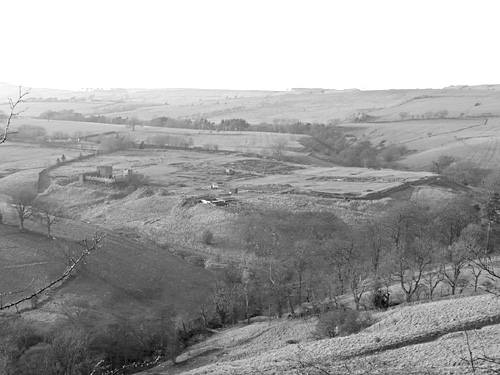
Vindolanda Tablets OnlineAs we reported in Newletter 9, an online edition of the Vindolanda tablets is currently under development at the Centre for the Study of Ancient Documents as part of the Andrew W.Mellon Foundation funded programme, 'Script, Image and the Culture of Writing in the Ancient World'. 
View over the site of Vindolanda, looking north-west from Barcombe Hill The website (http://vindolanda.csad.ox.ac.uk: currently in testing) is being built in collaboration with the University's Academic Computing Development Team. It will include the texts published in Tabulae Vindolandenses II by Alan Bowman and David Thomas, together with new digital images of all the texts. The opportunity to search and browse the texts, translations, commentaries and metadata will make the online edition of the tablets a more flexible research tool. An introduction to the context and content of the tablets, in the form of a virtual exhibition, will facilitate access to the tablets for students, schools and those with a general interest in the ancient world. As well as cross-references to the tablets themselves, the exhibition will be supported with other documents and archaeological material, including many illustrations of sites and artefacts. A 'reference' section will assist with more specific aspects of the tablets' content, for example Roman nomenclature and currency. Substantial progress has been made on the different elements of the site. The overall framework has been designed and built. Digital versions of all the resources for the online edition, together with metadata, have been compiled. The material is organised and stored in a 4th Dimension database, which will also store other groups of documents included in the Mellon programme. A trial version of the exhibition and reference sections is now ready. The web publication of epigraphic and papyrological documents offers several challenges. We want to offer large images of tablets without incurring prohibitive download times. This will be realised through a zoom facility: a frame moved over a smaller tablet image calls up from the server a larger version of the area of the image within the frame. The layout of individual tablets must accommodate a large number of entities, including images, text, translation, notes and metadata. Our solution offers a customisable framework: some resources can be switched on or off whilst others may be explored through pop-up windows, for example the larger 'zoomable' images, notes and bibliography. Perhaps the most acute challenge is posed by the mark-up and display of the texts themselves. Some of the typographic conventions used to mark-up printed texts cannot be consistently reproduced on the web. New, more digital-friendly conventions must therefore be adopted. In choosing these conventions, we have followed three guidelines: they must contain all the functionality of the print conventions, they must be compatible with other digital epigraphic corpora, and they must be based on common and current technology. Given these concerns, we think that the Epidoc DTD - an XML standard for the encoding of ancient documents under preparation by an international consortium of which the CSAD is a member (http://www.unc.edu/awmc/epidoc/) - is the best option presently available, although it is still under development. The Vindolanda texts will therefore be marked up in XML following the Epidoc conventions. For display on the website, these XML texts will be converted into HTML by XSL stylesheets. Using style- sheets allows us to be flexible about the final appearance of the documents and to customize the display for each individual project. Perhaps the thorniest display issue is the representation of uncertain readings, indicated in print by a subscript dot. It is not yet possible to present this in a stable form across different browsers. Our currently favoured alternative is to differentiate such readings by faded text. This and the rest of the website will be evaluated by testers in late summer and early autumn 2002. If readers would like to view the prototype site and take part in the evaluation, please contact us. The site will be launched in the winter of 2002. John Pearce (john.pearce@classics.ox.ac.uk)
Home | What's New | Events | Images | Links |
| Created on |